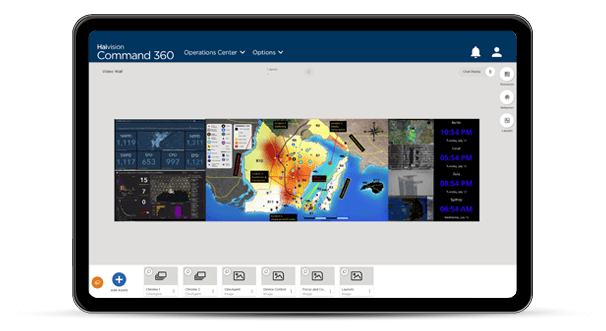In our last posting, we introduced some of the world’s highest-resolution digital signage video walls, high-impact displays designed to command attention in even the busiest spaces. The video walls on our next list leverage ultra-high-resolution technology for a different purpose: advanced visualization.
In prominent universities and research institutions around the world, video walls are emerging as the preferred tool for big data visualization and collaborative exploration. Uniting ultra-high-resolution displays with powerful processing and rendering systems and innovative software, these video walls allow researchers to process, analyze, and interact with content in ways that were previously impossible.
As you’ll see, advanced visualization video wall systems are used to perform highly specialized and complex tasks and often must integrate with a range of devices, software, and even supercomputers. To create these unique systems, institutions must look beyond simple, “one-size-fits-all” video wall solutions. Some leverage partnerships with special manufacturers and integrators that can provide high-performance, ultra-customized solutions and are willing to work collaboratively with their customers to design the system. Other institutions prefer to purchase off-the-shelf components of their choosing and build the video wall system in-house. Our list includes examples of both scenarios.
Now, let’s take a look at some of the highest-resolution advanced visualization video walls in the world!
#7 LambdaVision

Institution: Electronic Visualization Laboratory, University of Illinois at Chicago
Total Resolution: 105 million pixels
Technology: LCD
Contributors: University of Illinois at Chicago

Located in UIC’s Electronic Visualization Laboratory (EVL), the LambdaVision video wall provides ultra-high-resolution visualization for collaborative research. Researchers and students in the geosciences, computer sciences, and other disciplines leverage LambdaVision’s 105 million pixels to visualize high-resolution models, maps, and massive data sets. The system, which was designed and built by UIC researchers, is comprised of 55 LCD displays with resolutions of 1600×1200 each. An array of display nodes, powered by embedded computers running the university’s SAGE software, render and display graphics on the displays. In addition to aiding university research, LambdaVision supports collaboration between various experts and agencies to enhance disaster response and crisis management. Using LambdaVision’s powerful processing and ultra-high-resolution capabilities, teams can view real-time footage of natural disasters alongside stored city, regional, and national maps.
Further Reading:
LambdaVision, the 100Mpixel Display
ABOUT LambdaVision
#6 Cylindrical Varrier
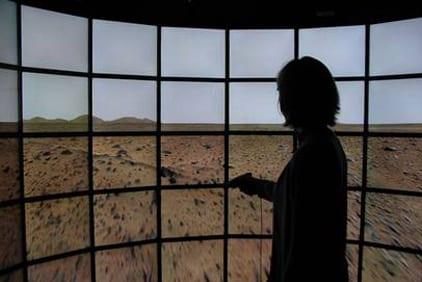
Institution: California Institute for Telecommunications and Information Technology, University of California, San Diego
Total Resolution: 125 million pixels
Technology: LCD
Contributors: University of California, San Diego; University of Illinois at Chicago

Located in the California Institute for Telecommunications and Information Technology (Calit2) at UC San Diego, the Cylindrical Varrier autostereoscopic virtual reality system provides an immersive virtual reality experience without requiring users to wear 3D glasses or tracking devices. The Cylindrical Varrier at UC San Diego is actually the highest-resolution video wall in a series of similar Varrier systems, the products of an ongoing cooperative research project involving the Electronic Visualization Laboratory (EVL) at the University of Illinois at Chicago and Calit2 at UC San Diego. The Cylindrical Varrier is composed of 65 tiled LCD panels with resolutions of 1600×1200 each. The Varrier system is groundbreaking in that it produces a true virtual reality experience with head-tracked first-person perspective, large angles of view, stereoscopic display, and real-time interactivity. In addition to not wearing any devices, the user does not need to be positioned in pre-determined viewing zones to experience the virtual reality effect. Cylindrical Varrier’s ultra-high resolution display and curved mounting structure further enhance the immersive experience.
Further Reading:
35 Panel Cylindrical Varrier™ Autostereo Display
#5 Visualization Wall

Institution: Petit Science Center, Georgia State University
Total Resolution: 200 million pixels
Technology: LCD
Contributors: Haivision; Georgia State University

Located in Georgia State University’s Petit Science Center, the Visualization Wall is a powerful tool for faculty and researchers of all disciplines. The 200 million pixel Haivision video wall enables users to explore ultra-high-resolution content in order to better understand complex data sets or examine visual systems side by side. The massive display is composed of forty-eight HP LCD displays with resolutions of 2560 x1600 each and is supplemented by four 2560×1600 panels in an adjacent workstation. The curved shape of the Visualization Wall transforms the system into a truly immersive environment. A cluster of four Bravo Viz controllers provide powerful processing and 2D and 3D content rendering capabilities, allowing researchers to view massive data at full scale and precise detail simultaneously. The first Microsoft Windows-based system of its kind, the Visualization Wall is designed to be accessible to researchers from all disciplines and to encourage cross-disciplinary collaboration. Researchers use the Visualization Wall to explore widely diverse content, from Renaissance frescoes to 3D geological maps and bacterial growth.
#4 HIPerWall
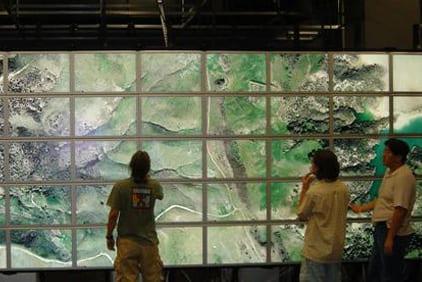
Institution: California Institute for Telecommunications and Information Technology, University of California, Irvine
Total Resolution: 205 million pixels
Technology: LCD
Contributors: University of California, Irvine

UC Irvine’s HIPerWall (Highly Interactive Parallelized Display Wall) provides ultra-high-resolution visualization for experimental and theoretical researchers at the California Institute for Telecommunications and Information Technology. Designed and built by UC Irvine researchers, the 205 million pixel video wall is constructed from an array of fifty 30″ Apple Cinema LCD displays with resolutions of 2560 x 1600 each. Primarily used for Earth science, biomedical science, and engineering visualization, the system enables researchers to view large, multi-dimensional, time-varying datasets. HIPerWall leverages a clustered computing architecture of 25 nodes that transfer and manipulate content on the displays and can even receive real-time simulation data from UCI’s Earth System Modeling Facility supercomputer. The HIPerWall project, completed in 2005, generated the spinoff company Hiperwall Inc., which now sells video walls based on cluster parallel processing architecture similar to that used in the original HIPerWall.
Further Reading:
UC Irvine’s monster HIPerWall monitor
Research Projects: HIPerWall
#3 Hyperwall-2
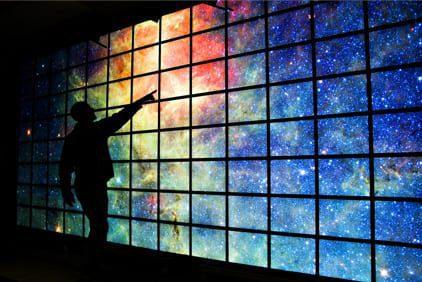
Institution: NASA Advanced Supercomputing Division at Ames
Total Resolution: 256 million pixels
Technology: LCD
Contributors: NASA, Colfax International

#2 HIPerSpace
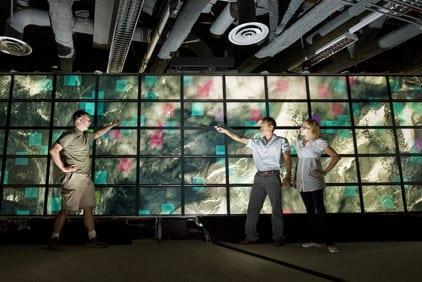
Institution: California Institute for Telecommunications and Information Technology, University of California, San Diego
Total Resolution: 287 million pixels
Technology: LCD
Contributors: University of California, San Diego

A 2008 expansion of a system originally built two years before, HIPerSpace (Highly Interactive Parallelized Display Space) now provides an astonishing 287 million pixel visualization environment for the UC San Diego research community. HIPerSpace was expanded to allow researchers to visually explore increasingly complex and massive data. Standing 31.8 feet wide and 7.5 feet tall, the video wall is composed of an array of 70 Dell 30” displays, each with a resolution of 2560 x 1600. A cluster-based processing and rendering system with a total of 100 processor cores and 38 GPUs enable HIPerSpace to display high-resolution simulations, interactive models, and more. Researchers from various disciplines use the system to explore such diverse content as medieval architectural structures, seismic activity, and the human brain.
#1 Stallion
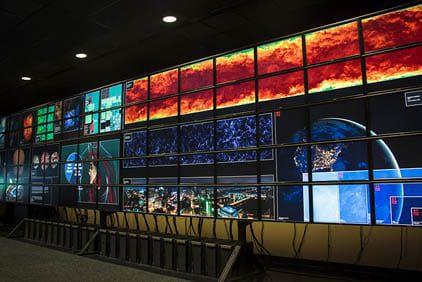
Institution: Texas Advanced Computing Center (TACC), University of Texas at Austin
Total Resolution: 328 million pixels
Technology: LCD
Contributors: Texas Advanced Computing Center

Displaying an astounding 328 million pixels, the Stallion video wall takes our first place position as the highest resolution advanced visualization video wall system in the world today. Located in the Texas Advanced Computing Center’s ACES Visualization Laboratory at the University of Texas at Austin, Stallion consists of 80 widescreen Dell LCD monitors with individual resolutions of 2560 x 1600. The system is built on a cluster-based parallel processing architecture and driven by a total of 256 processing cores and 46 GPUs. Stallion provides its research community with both high performance and great versatility. Various research groups have leveraged its powerful processing and rendering capabilities to explore content like electron microscopy, hurricane simulations, satellite imagery of archeological excavation sites, and much more.
Further Reading:
STALLION 328 MEGAPIXEL TILED-DISPLAY
We hope you’ve enjoyed reading about some of today’s highest-resolution advanced visualization video walls! Stay tuned as today’s leading research institutions continue to push the limits of ultra-high-resolution visualization.
